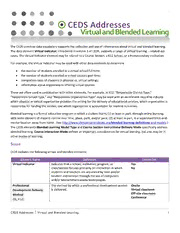
ERIC ED566886: CEDS Addresses: Virtual and Blended Learning PDF
Preview ERIC ED566886: CEDS Addresses: Virtual and Blended Learning
The CEDS common data vocabulary supports the collection and use of information about virtual and blended learning. The data element Virtual Indicator, introduced in version 3 of CEDS, supports a range of virtual learning – related use cases. The Virtual Indicator element may be related to a Course Section, a K12 School, or a Postsecondary Institution. For example, the Virtual Indicator may be used with other data elements to determine the number of students enrolled in a virtual school full time; the number of students enrolled in virtual courses part time; completion rates of students in physical vs. virtual settings; information about organizations offering virtual courses. These are often used in combination with other elements. For example, in K12, “Responsible District Type,” “Responsible School Type,” and “Responsible Organization Type” may be used with an enrollment record to indicate which physical or virtual organization provides the setting for the delivery of educational services, which organization is responsible for funding the service, and which organization is accountable for student outcomes. Blended learning is a formal education program in which a student learns (1) at least in part, through online learning, with some element of student control over time, place, path, and/or pace; (2) at least in part, in a supervised brick-and- mortar location away from home. (See http://www.christenseninstitute.org/blended-learning-definitions-and-models.) The CEDS elements Blended Learning Model Type and Course Section Instructional Delivery Mode specifically address blended learning. Course Interaction Mode defines an important consideration for virtual learning, but also may be in other modes of learning. Scope CEDS includes the following virtual and blended elements: Element Name Definition Option Set Virtual Indicator Indicates that a school, institution, program, or Yes class/section focuses primarily on instruction in which No students and teachers are separated by time and/or location and interact through the use of computers and/or telecommunications technologies. Professional The method by which a professional development session Onsite Development Delivery is delivered. Virtual classroom Off-site classroom Method Conference (EL, K12) CEDS Addresses Virtual and Blended Learning 1 Technical Assistance The method of delivery of technical assistance Onsite Delivery Type received/provided. Virtual classroom Off-site classroom Conference Course Interaction Mode The primary type of interaction, synchronous or Asynchronous (K12) asynchronous, defined for the course. Synchronous Blended Learning Model A type of formal education program in which a student Rotation model Type learns at least in part through online learning, with some Flex model element of student control over time, place, path, and/or A La Carte model (K12) pace; in which the student learns at least in part in a Enriched Virtual model1 supervised brick-and-mortar location away from home; and in which the modalities along each student’s learning path within a course or subject are connected to provide an integrated learning experience. Course Section The primary setting or medium of delivery for the course. Broadcast Instructional Delivery Correspondence Early College Mode Interactive Audio/Video (K12, CTE) Online Independent Study Face to Face Blended Learning Distance Education An individual's enrollment in a course or courses in which Enrolled Exclusively Course Enrollment the instructional content is delivered exclusively via Enrolled In Some distance education. Distance education is education that Not Enrolled (Postsecondary) uses one or more technologies to deliver instruction to students who are separated from the instructor and to support regular and substantive interaction between the students and the instructor synchronously or asynchronously. Technologies used for instruction may include the Internet; one-way and two-way transmissions through open broadcasts, closed circuit, cable, microwave, broadband lines, fiber optics, satellite or wireless communication devices; audio conferencing; and video cassette, DVDs, and CD-ROMs, if the cassette, DVDs, and CD-ROMs are used in a course in conjunction with the technologies listed above. Distance Education An individual's enrollment in a program for which all the Yes Program Enrollment required coursework for program completion is able to be No completed via distance education courses. Distance Indicator education is education that uses one or more (Postsecondary) technologies to deliver instruction to individuals who are separated from the instructor and to support regular and substantive interaction between the individuals and the instructor synchronously or asynchronously. 1 Option definitions adapted from http://www.christenseninstitute.org/blended-learning-model-definitions/. CEDS Addresses Virtual and Blended Learning 2 Course Instruction The primary method of instruction used for the course. Lecture Method Laboratory Seminar (Postsecondary) IndependentStudy PrivateStudy PracticeTeaching Internship Practicum ApprenticeshipExternship AppliedInstruction Residency ClinicalRotationInstruction SelfPaced FieldStudy InternetInstruction InteractiveVideo Videotape Television OtherDistanceLearning Audiotape ComputerBasedInstruction CompressedVideo Correspondence CooperativeEducation WorkStudy Adult Education Special The type, by location or delivery mode, of adult education Correctional education Program Type instruction program in which an adult participates. program in facility or community (Adult Education) Family Literacy Workplace Literacy Program for the Homeless Co-enrollment in adult education and postsecondary education Distance Education Proxy Contact Hours The number of instructional hours completed by an adult None (Adult Education) enrolled in a distance learning program. CONNECTions CEDS CONNECT is an online resource mapping CEDS data elements to specific uses or questions. The free tool allows a registered user to create a “CONNECTion” that defines what data elements and business rules apply to certain questions, such as “In what schools are students enrolled in an ‘À La Carte model’ of blended learning and in what subject areas?” The following CEDS Connections are available: Connection URL Blended Learning Elements in CEDS https://ceds.ed.gov/connectManageCase.aspx?UseCaseId=136 (Other CONNECTions may be developed from time to time. Please visit http://ceds.ed.gov for more information.) CEDS Addresses Virtual and Blended Learning 3
